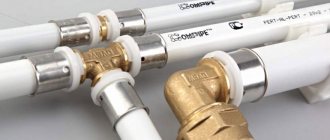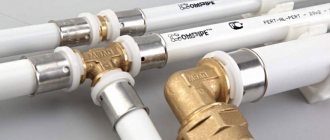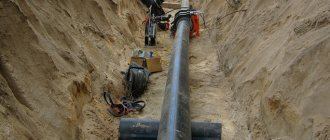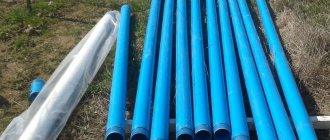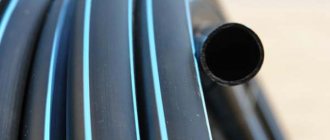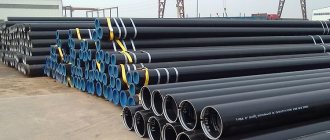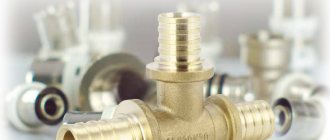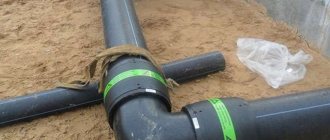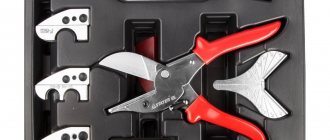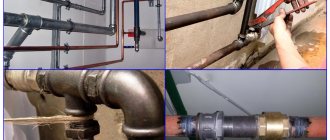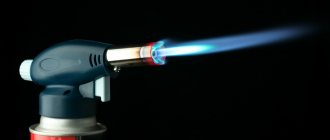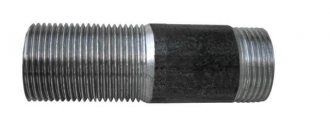“PVC” stands for polyvinyl chloride - a material that has good performance characteristics under heavy loads, as well as significant temperature changes. PVC pipes (white, orange, black, etc.) are very popular in today's communications products market. Often, on their basis, an external or internal sewerage network, a drainage system is built, cold and hot water is connected, and an electrical cable is laid.
Using PVC pipes, you can organize water supply and sewerage for a residential building or public facility without any special costs.
PVC - what is it
Not so long ago, the use of this thermoplastic in construction was significantly limited due to sensitivity to high temperatures, but modern technologies have radically changed the situation. At the moment, PVC pipes occupy a leading position among communication materials and are even used in heating circuits.
PVC is a colorless thermoplastic synthetic polymer of organic origin. It is made from chlorine obtained from a solution of table salt and ethylene isolated from petroleum. But the resulting PVC granulate, in fact, is only a raw material base for the production of a huge number of varieties of PVC materials (including for heating circuits).
Classification of PVC polymers and abbreviations
The simplest PVC (PVC) stands for PolyVinyl Chloride.
Depending on the polymerization technology, PVC materials are classified into 2 groups:
- Plasticized (PPVC, PVC-P, PVC-P, FPVC, PVC-F).
- Unplasticized (PVC, PVC-N, PVC-U, RPVC, PVC-R).
Modified chlorinated polyvinyl chloride (CPVC, PVC-C, CPVC) is classified into a separate category.
Conclusion
To lay a reliable and durable pipeline based on PVC pipes, their properties should be taken into account. It is best to use them in those areas for which they are recommended by the manufacturer. In addition, it should be taken into account that the operational properties of the system largely depend on the quality of its installation.
You can get more information on this topic from the video in this article.
Previous post Brass pipe: distinctive features and classification
Next entry Pipe iron: device features and operating rules
Specifications
The technical and operational properties of the material are explained by the zigzag molecular structure of the polymer.
Physico-chemical features
| Characteristics | PVC | CPVC |
| The proportion of chlorine in the composition | 44% | 56% |
| Density, g/cm3 | 0,95-1,46 | 1,47-1,6 |
| Melting temperature | 100-260 °C | 260-395 °C |
| Glass transition temperature | 70-80 °C | 105-120 °C |
| Decomposition temperature | 100-120 °C | 120-140 °C |
| Temperature minimum | -15 °C | |
| Modulus of elasticity, MPa | 550-1200 | 2400—2700 |
| Yield strength, MPa | 18-26 | 50-55 |
| Design strength, MPa | 6,3 | 10 |
| Tensile strength, MPa | 40-50 | 50-80 |
| Bending strength, MPa | 80-120 | |
| Thermal conductivity, W/(K∙m) | 0,14-1,63 | 0,13-0,22 |
| Specific heat capacity, J/(kg K) | 90 | |
| Linear expansion index | 1,2-1,4 | 0,62 |
| Gas permeability | 13 | 1 |
| Roughness coefficient | 0,006 | |
| Dielectric constant (at 50 Hz) | 3,5 | |
| Fire safety class | KM3 | |
| Flammability class | G2 | |
| Flammability class | AT 2 | |
| Flash point | 620 °C | |
| Flash point | 500 °C | |
| Auto-ignition temperature | 1100 °C | |
| Smoke emission class | D3 | |
| Toxicity class of combustion products | T2 | |
Performance properties of PVC pipes: pros and cons
PVC pipe products differ:
- High strength and resistance to significant hydraulic pressure, mechanical stress and deformation (especially unplasticized forms of the polymer).
- Resistant to oxidation and rust.
- Immunity to most chemicals: alcohols, acids, alkalis, salts, mineral oils, solvents.
- Lightness, which makes it easier to deliver and work with the material, and also reduces the overall structural loads of the building.
- High plasticity (characteristic mainly of plasticized PVC), which facilitates mechanical processing of pipes: cutting, bending, welding.
- Low roughness index, which helps maintain the required hydraulic pressure and prevents sedimentation inside the circuit.
- Resistant to weather conditions and temperature changes.
- The dielectric properties of PVC, they do not conduct current and are resistant to stray currents. However, these qualities are lost when heated above 85°C.
- Biological inertness. Plastic pipes are not susceptible to microorganisms and are not a favorable environment for their development.
- Environmentally friendly, since during operation the circuits do not emit harmful substances into the atmosphere. However, if operating conditions are violated (heating above normal), the process of molecular decomposition of the material starts, accompanied by the release of hydrogen chloride.
- Wear resistance, allowing trouble-free operation of engineering systems made of polyvinyl chloride for 50-80 years.
- The ability to recycle pipes, which compensates for one of the most important disadvantages of PVC - the difficulty of disposal.
PVC pipes are fireproof. Unlike most plastics, the ignition temperature of PVC materials is much higher; in conditions of critically high indicators, they simply melt before reaching the maximum. Combustion is accompanied by the release of toxic substances, but the burning polymer itself does not lead to the spread of fire, since it lacks the characteristic flame of most polymers. As soon as the source of fire is eliminated, polyvinyl chloride materials self-extinguish.
What temperature can it withstand?
Limited temperature conditions are perhaps the biggest drawback of polymer pipes.
PVC pipes are no exception:
- The operating temperature range of most PVC pipes is limited to the range from 0 to 65 °C (for chlorinated varieties - from 0 to 95 °C).
- At subzero temperatures, the material becomes brittle, and at temperatures below -15 °C, the pipeline with the carrier inside can simply break. As a result, when laying externally or immersed in the ground, a PVC pipeline requires careful insulation.
- Under conditions of excessive heating of the circuit (70-105 °C), the effect of “glass fragility” occurs.
- The moment when the PVC pipe loses its shape (“floats”) is considered critical, which occurs when heated to a temperature of 100-260°C.
However, depending on the conditions and formulation of PVC production, as well as the thickness of the pipe wall, these characteristics will be different for each thermoplastic model.
Regulations
The creation of plastic profiles is regulated by various state standards and rules in accordance with their purpose. Products used for water supply, heating, ventilation and gas supply are subject to certification.
There are no specific state standards for the production of profiled polymer pipes. Recommendations for their manufacture are contained in the manufacturers' documentation.
Standards and GOSTs
They are guided by GOST standards for the installation of certain pipelines. For example, GOST 32548-2013 “Ventilation of buildings”.
Various technical conditions approved by higher control authorities are also used.
- TU 2248-001-09801575-2010 (for non-pressure communications).
- TU 2247-001-88915836-2010 (for sheet and profile products made of thermoplastics).
- TU 6-19-215-86 (for PVC-U insulation boxes).
How are plastic pipes obtained?
The production and quality control conditions of PVC pipes are regulated by numerous GOSTs, among which the main ones are P 51613-2000, 32415-2013 and 28117-89.
Raw materials for production
PVC granulate is used as a raw material for the production of pipes. It may already be plasticized, but most often unplasticized modifications are used. Various fillers are mixed into them to improve the physical and chemical characteristics of the PVC polymer:
- Plasticizers that soften hard plastic, giving it elasticity and flexibility.
- Thermal stabilizers that increase the resistance of PVC pipes to heat.
- Dyes that give the transparent polymer mass the desired color.
For technical pipes, recycled PVC material is often used.
Manufacturing technology
For the production of pipes, continuous extrusion and pressing technologies are used:
- PVC granules are poured into the extruder hopper, which under high pressure and heat are fused into a plastic mass.
- The semi-liquid mass is sent to the working chamber, where under the action of a pusher, forming heads, matrix and mandrel, a blank of the future pipe is formed, its internal and external diameters are fixed.
- The workpiece is then transferred to a vacuum calibrator, where it is stretched to the desired size. At the same stage, the wall thickness specified by the parameters is formed.
- The resulting PVC product is fed by an automated line into the cooling bath.
- After cooling, the pipe is marked, cut with a guillotine knife into the required sections, and, if necessary, twisted into coils.
For the production of corrugated PVC channels, the automated line is supplemented with a special unit - a corrugator, which, in addition to corrugation, performs a cooling function, so there is no need to use a cooling bath.
Cautions
Possible problems may be caused by installation errors, mechanical damage during operation, or manufacturing defects.
If such damage is detected on a plastic pipeline, you can use one of the following methods to temporarily eliminate the accident:
- Metal clamp . The first step is to stop the movement of liquid inside the pipe, then use a clamp to cover the leaking area by tightening the side bolts.
- Rubber . In this case, the problem area is tied with a piece of rubber: a clamp is installed on top of it or a wire is wound.
- Painting . If we are talking about a minor leak, you can apply paint by spreading it over the fabric winding.
- Glue . The damaged area is cleaned, degreased and degreased. To seal a through hole, it is better to use two-component epoxy glue. In this case, a fiberglass bandage or sealing tape is used to wrap the problem area.
- Cold welding . This way you can connect or repair any plastic pipes. After preparing the surface, the problem area is sealed with plastic material, which is previously kneaded in the hands. Having wrapped the sealed area with a tourniquet, you need to wait an hour, after which the protruding parts of the hardened material are cut off or sawed off.
Purpose and scope of application
Excellent performance characteristics and a wide range of PVC pipes contribute to their widespread use in the construction of diverse engineering communication systems.
Pipelines made of polyvinyl chloride are actively used today:
- For organizing cold and hot water supply.
- For installation of external and internal circuits of domestic sewage systems - both gravity and pressure.
- For arrangement of storm drains and drainage systems.
- For laying underground communications, including those running under sidewalks, roads, and railways, which create a fairly serious load on the pipeline. In this case, predominantly unplasticized PVC is used, which has increased rigidity and resistance to external influences.
- For open or hidden installation of electrical, telephone and other types of cables.
- For casing wells.
Ventilation ducts
Plastic ventilation ducts fit harmoniously into the interior design of the room.
And the presence of a visor adds elegance and sophistication. This element allows you to hide not only flat, but also round channels.
They are used not only in everyday life. This type of duct is often used to construct an exhaust duct in offices and small commercial premises.
Video
Installation of plastic air ducts from VENTS specialists (video from Channel 5)
The advantages include:
- Smooth surface outside and inside.
- High strength index.
- High connection rate.
- Simplicity and ease of cleaning the surface.
- Presentable appearance.
The disadvantages of this design include its high cost when compared with galvanized and flexible options. This also includes limiting the diameters of PVC channels produced.
Classification, types and range of PVC pipes
| Classification characteristics | Types of PVC pipes |
| Purpose | Plumbing |
| Sewer | |
| Heating | |
| Casing | |
| Electrical | |
| Strength class | Lungs |
| Average | |
| Heavy | |
| Reinforced | |
| Modulus of elasticity and bending radius | Corrugated |
| Flexible | |
| Hard | |
| Form | Round |
| Profile (square, rectangular) | |
| terms of Use | Pressure |
| Gravity | |
| For discharged environment | |
| Low temperature | |
| Medium temperature | |
| High temperature |
In addition, there are different PVC models designed for internal or external, hidden or open installation of circuits.
The range of PVC pipes is determined by GOSTs. The manufacture of products outside the standardized standard sizes is negotiated between the customer and the manufacturer as part of an individual order.
Plumbing
For the installation of hot and cold water supply networks, smooth gray PVC-U pipes intended for socket connections are used. They are resistant to the pressure created by the circuit when water is supplied. The chemical resistance and antibacterial qualities of plastic make them safe for transporting drinking water. The concentration of chlorine in PVC material is quite low, so it is not capable of causing harm to health.
The temperature regime of DHW systems made of uPVC is usually limited to 45 °C. At higher rates, modified CPVC pipes are used.
Sewer
PVC sewer pipes are used for transporting domestic wastewater and technical liquids with a carrier temperature of no more than 60 °C. Manufactured in accordance with the standards TU 2248-057-72311668-2007.
| Types of sewer pipes | Features of operation |
| Pressure | Arrangement of sewage drainage in systems equipped with pumping stations |
| Gravity | Organization of sewerage and storm water drainage systems of gravity type |
| Lungs (SN-2) | Laying the sewer circuit in buildings and areas with minimal load |
| Medium density (SN-4) | Laying sewer lines under sidewalks and roads with moderate loads |
| Heavy (SN-8) | Consolidation of sewer circuits of apartment buildings into a single network, their laying under roads with increased traffic load |
| Hard | Used on straight sections |
| Corrugated | Allows you to create the desired bend without using rotary fittings. Most often used to connect household plumbing fixtures to the sewer system |
There are also models designed for installation indoors or outdoors. You can distinguish them by the color of the PVC: the first ones are gray, the second ones are orange.
PVC pipes for heating
Heating tasks require the circulation of a fairly hot coolant, so ordinary PVC pipes are not used for these purposes, but circuits made of chlorinated polyvinyl chloride (CPVC) are ideally suited.
Features of CPVC pipes:
- Reduced thermal conductivity coefficient, which allows minimizing heat losses during the delivery of heated media to heating radiators.
- Recommended for use in underfloor heating systems and circuits operating on gas and solid fuel boilers.
- The connection of CPVC elements is carried out only by gluing. For these purposes, a special high-molecular adhesive is used.
CPVC pipes reinforced with fiberglass or aluminum mesh have improved performance characteristics (increased strength and resistance to temperature changes).
Electrical
Electrical PVC pipes are designed for laying electrical wiring and other types of cables. They isolate wires from external influences and provide fire protection to the room in which the cable channel is laid.
PVC pipes are available in white and gray colors and are presented in several modifications:
- Flexible, corrugated, rigid.
- Round, profile.
- Whole, prefabricated.
- Single-walled, double-walled.
- With or without cable pulling function.
Cable channels can be laid openly (on top of walls), or hidden (embedded in concrete).
The abbreviation “DKS” has long become a common name for all cable support systems in Russia. In fact, this is the name of the manufacturer, which stands for “Dielectric Cable Systems”.
Casing
The unconventional use of casing pipes puts them in a category of their own. With their help, drilled wells are lined and the walls are strengthened to prevent soil from collapsing.
This technology has found wide application in various fields of industry and agriculture. In construction, casing columns are used not only to mark the boundaries of wells, but also to pour concrete into bored supports. In the field of private construction, casing technology is used in the construction of water wells and pressure water intake wells.
Features of plastic casing pipes:
- The color is blue or light blue.
- Connection type: threaded. The products are produced in rigid sections screwed into each other, with an internal trapezoidal thread on one side and an external thread on the other.
- The pressure created by the soil requires PVC casing products to have a high degree of strength and maximum pipe wall thickness (7-20 mm).
Production standards and assortment of casing strings are regulated by TU 2248-001-84300500-2009.
Profile (square, rectangular) PVC pipes
It is noteworthy to use plastic pipes of rectangular and square cross-section. With their help:
- Air ducts for ventilation circuits are assembled.
- Frames of greenhouses are being erected.
- Automatic nipple-type drinking systems are being created for birds and animals.
- Profiles of plastic windows are produced.
- Electrical wiring is being installed in the premises.
- Furniture is produced.
Painting of profile pipes is purely decorative.
Difference between flexible and corrugated PVC pipes
Despite the apparent similarity of flexible and corrugated PVC channels, they have fundamental differences in appearance and technical capabilities.
| Characteristics | Flexible | Corrugated |
| Raw materials for production | Plasticized PVC | Both plasticized and non-plasticized types of PVC |
| Appearance | Smooth, flat surface both inside and outside | Embossed on the outside and smooth or corrugated on the inside (depending on the type of product) |
| Bend radius | 1-2 diameters | 3 diameters |
| Dependence of flexibility parameters on ambient temperature | + | — |
| Possibility to change length by stretching | — | + |
Some models of corrugated pipes used as cable ducts are equipped with a metal broaching thread - a probe, which simplifies cable laying.
The main advantage of flexible and corrugated pipes is the ability to build any wiring diagram, even in hard-to-reach places, with a minimum number of adapters and other fittings. This not only facilitates and speeds up installation work, but also allows you to save a considerable part of the budget.
Corrugated pipes are available in 3 modifications:
- Single-walled, having the same relief surface inside and outside.
- Double-walled. In them, the inner surface of the contour, unlike the outer one, has a smooth structure. The lack of relief inside the pipe is an advantage for pipelines associated with the transportation of liquid media. The corrugation of the internal circuit promotes the formation of deposits and requires periodic preventative cleaning to prevent blockages.
- Reinforced pipes, the shell of which has a spiral frame built into it, increasing the ring rigidity of PVC products. It is not easy to deform or break such a pipeline.
Pressure and non-pressure PVC pipes
The difference between pressure and non-pressure systems of domestic drinking water supply, sewerage or industrial pipelines lies in the principle of organizing the movement of the carrier:
In non-pressure circuits, the flow of the carrier is based on the natural laws of gravity, is carried out by gravity, and is possible only in the direction from top to bottom.
Pressure lines are used when it is not possible to maintain slopes corresponding to gravitational principles or when it is necessary to redirect the flow of liquid from bottom to top. For this purpose, the pipeline is equipped with a circulation pump that creates the necessary pressure in the circuit.
In such conditions, increased strength requirements are placed on pressure pipes. They must withstand pressure in the circuit in the range from 6 to 16 atmospheres.
There are 2 types of pressure pipes:
- PVC-U 125, designed for an average operating pressure of 12.5 MPa.
- UPVC100 with an average working pressure of 10 MPa.
It should be taken into account that the level of operating pressure in the circuit also depends on the SDR index, which reflects the ratio of wall width to diameter:
To make it easier to distinguish a non-pressure pipe from a pressure analogue, the labeling of a PVC product includes the inscription “not for pressure”.
Bell-shaped
Bell-shaped PVC pipes are products with a funnel-shaped expansion at one end (bell), designed to quickly and tightly connect several circuit elements into a single pipeline.
The configuration and configuration of the PVC socket is determined by the type of installation of the circuit. Highlight:
- Glue sockets.
- Bells with sealing ring.
The dimensions of the socket vary depending on the operating conditions of the PVC circuits:
- For internal use the following values are recommended:
- For outdoor use or pipeline laying in conditions of large differences in height (for example, in mountainous areas), PVC products with an elongated socket are used:
Fiberglass
Their main advantages:
- Even with their large dimensions, a diameter of over 500 mm and a length of 6 and 12 m, fiberglass products are relatively lightweight.
- The material of this type of pipe is durable and reliable, from an environmental point of view it is impeccably clean, and in terms of chemical aggression it is completely neutral.
- The service life of fiberglass pipes is more than half a century.
- These pipes are connected to each other and to other shaped products using double-cone special couplings. On their inner side there are grooves for mounting elastomeric sealing rings - one on each side, and one ring is located in the center. Thanks to this mating, the joint is precisely centered and reliably sealed.
Main nuances when laying pipes:
When preparing a sewer system, it is important to know that the pipeline does not have to be laid deep. The standard option is when it is located above the pipelines of the general drainage system around a building or land plot. Despite the fact that the likelihood of storm drainage pipes defrosting is very small, experts still advise laying them at a depth slightly below the soil freezing level, which is typical for each region. If for some reason such actions cannot be performed, all pipes must be insulated and the thermal insulation layer covered with plastic film to prevent moisture from groundwater from entering it. For the system to function fully, the pipes must be laid at an angle in the appropriate direction. The slope of pipes for rainwater drainage, ensuring the free passage of waste liquid and its regular self-cleaning, should be from one to two centimeters per linear meter of pipeline
If this rule is not followed, the internal cavities of the system will often become clogged. Such unpleasant phenomena occur at pipe joints or corner turns.
Recent data on prices for stormwater pipes have shown that when designing stormwater drains, the best option would be to use a corrugated multilayer stormwater pipe. Compared to similar types, its purchase will provide significant financial savings of up to 30-50%.
If you correctly calculate and correctly install the sewerage pipeline system, then in general the entire stormwater system will function without failures for a long time.
Features of choice
When choosing PVC pipe fittings, you should be guided by several factors:
- Purpose and operating conditions. This means that products intended for sewerage should not be used for water supply, and products intended for open installation are not suitable for pouring contours from it into concrete.
- Pipe strength class. If you plan to immerse a PVC pipeline into the ground, preference should be given to a higher strength class, not forgetting to take into account the calculated burial depth.
- Design calculation data, which reflects the footage, diameters, quantity, purpose of shaped elements, and other parameters of the future circuit.
- Appearance of PVC products. The surface of the pipes must be smooth and evenly colored. The presence of chips, cracks, depressions or bubbles indicates low quality.
Be sure to check the product’s compliance with GOST. This ensures that the product has passed all required strength tests.
All necessary information can be read from the markings, which should be applied directly to the PVC pipe at intervals of 1-1.5 meters.
How to choose the right heating pipes
Let us repeat, only CPVC pipes are used for heating:
- Give priority to reinforced CPVC products. They cost more, but last 20-30 years longer.
- Due to their reduced thermal conductivity, plastic pipes make it possible to make the pipeline cross-section smaller than with steel counterparts. By choosing a pipe with a smaller diameter, you will save on the volume of coolant without losing the quality of heat transfer.
The choice of the size of the thermal circuit should be based on data from thermal and hydraulic calculations.
What sizes of risers are optimal for heating systems?
The optimal option for PVC risers is considered to be diameters of 15-20 mm. The second option for heating circuits is preferable when used in apartment buildings, where the quality of the network coolant leaves much to be desired.
average price
| Purpose | Brand | Manufacturer country | Model | PVC type | Outer diameter, mm | Wall thickness, mm | price, rub. |
| Tap | ERA | China | PN16 | PVC-U | 20 | 2 | 39 |
| 40 | 3 | 121 | |||||
| Hemkor | Russia | SDR 41 PN6.3 | 90 | 2,2 | 90 | ||
| 110 | 2,7 | 131 | |||||
| Sewer | — | SN4 | PVSP | 110 | 3,2 | 168 | |
| 160 | 4 | 325 | |||||
| Sewer corrugation | ASKOR | Russia | one wall | PVC | 110 | 12 | 145 |
| Heating | CORZAN FIP | Italy | DN10 PN16 | CPVC | 16 | 1,2 | 218 |
| DN32 PN16 | 40 | 3 | 1130 | ||||
| ERA | Russia/China | PN25 | 32 | 3,9 | 362 | ||
| PN16 | 50 | 3,7 | 948 | ||||
| Electrical corrugated pipe | BUILDER | Russia | with probe | PVC | 32 | — | 16 |
| RUVINYL | 20 | 8,5 | |||||
| DKS | without broaching | 16 | 10 | ||||
| Casing | Cormell | — | uPVC | 125 | 5 | 300 | |
| Hemkor | 113 | 5 | 350 |
Connection methods
There are 2 main technologies used to connect PVC pipes:
- Soldering.
- Docking into a socket.
To transfer from PVC to a metal line, special adapter fittings are used, with metal threads mounted inside.
How to solder two plastic pipes
Soldering plastic pipes involves the mutual penetration of polymer particles of the joined elements into each other. This is done in one of the following ways:
- Using a special soldering iron.
- Using electrofusion fittings.
- Using high molecular weight glue.
The first 2 methods are based on heating the PVC and melting the plastic of the end parts of the parts being soldered.
The second is called a “cold solder” because no heating occurs. The edges of the elements to be joined are coated with a special adhesive composition, which is liquid PVC, which, after application, polymerizes in 5 minutes.
CPVC pipes are joined only using the “cold soldering” technology.
Socket connection technology
The socket connection technique simplifies the installation of PVC contours and the joining of elements made of different materials, for example, plastic with cast iron, asbestos cement or metal. Additional advantages are sealing and increasing the strength of the pipeline in the joint area, as well as ease of repair and dismantling work.
The principle of socket installation is simple. The straight end of one pipe is inserted into the extension of the other, where it is fixed and sealed depending on the type of socket:
- If the socket is equipped with a recess with a sealing ring, then to ensure tightness, the seal and the edge of the pipe are coated with silicone or glycerin sealant. This method of connecting PVC can withstand pressure up to 2 atmospheres.
- Fixation with an adhesive socket involves the use of either plumbing sealant (silicone or glycerin) or liquid PVC glue (the same as that used for “cold soldering”).
- The socket of PVC sewer risers is often fixed with concrete mortar, which is simply poured into the socket space formed as a result of joining the pipes.
Whatever method of PVC connection is chosen, you must not deviate from the central axis of the pipeline.
Flat ducts
Rectangular plastic pipes are used for laying flat plastic systems.
Their purpose is as follows.
- Creation of networks of supply and exhaust facilities for small and medium-sized premises.
- For constructing a flat outlet channel.
- For supplying exhaust and ventilation equipment.
Design features.
- Made from environmentally friendly, high quality material that is not subject to combustion.
- Wide temperature range of use (from -30 to +70 degrees).
- Low resistance to air flow.
- Long service life.
- Slight noise during operation.
- Economical use of space between the ceiling.
- Wide range of choices when searching for standard size and rating of flat pipe materials.
DIY installation tips
The high rigidity of PVC is the main problem when laying a pipeline, which increases the amount of work and costs. Pipes have to be cut (which increases the percentage of waste), and a considerable number of shaped elements must be introduced into the circuit, the cost of which sometimes amounts to about 50-70% of the entire construction budget.
The solution to the problem is a carefully thought-out wiring diagram and the correct choice of polymer for the circuit pipes.
How to bend correctly
Only plasticized PVC forms are suitable for bending. Attempts to bend a rigid pipe will lead to its deformation, loss of strength at the bend, and rupture.
You can bend a PVC pipe for a particular circuit using:
- A special pipe bender or spring, with the help of which the desired bend angle is formed.
- A construction hairdryer that provides heating of the desired area for greater plasticity.
- Sand, which evenly distributes and retains heat.
The pipe bender can be replaced with a wooden block with nails embedded in it or wooden choppers (nails) that serve as guides.
Progress:
- Sand is poured into the pipe, at the end of which a plug is pre-installed, using a funnel, which can be heated in advance.
- Then the bend area is blown with a construction hairdryer. Try to direct the hot air stream so that it evenly covers the folded area. Remember that excessive heating of plastic can lead to structural deformation, so the degree of heating of PVC must be constantly monitored.
- While warming up, begin to carefully bend the pipe.
Acceptable parameters for bending PVC pipes are indicated by the manufacturer in the technical documentation accompanying each product. The radius to which a particular pipe can be bent depends on the characteristics of the material, diameter, and wall thickness of the product.
How to install pipeline fittings
No pipeline can be installed without fittings. With their help, many problems are solved:
- The direction changes (bends, turn signals).
- Several circuits are routed and connected into a single line (tees, crosses).
- Products of different diameters and materials (adapters, gearboxes) are joined together.
- Linear expansion is compensated (compensation pipes).
The shaped elements are mounted in the same way as PVC pipes are connected by soldering or socketing.
How to make the transition from a cast iron pipe to a plastic sewer
The method of switching from a cast iron pipe to a plastic one depends on the type of cast iron section to which the plastic line will be connected:
- If the end of a cast iron pipe is made in the form of a socket, then a PVC pipe of smaller diameter is simply inserted into the cast iron extension or a special plastic adapter is used that imitates the socket of a PVC pipe.
- If the cast iron line was cut on a flat area, then a larger diameter socket adapter is used for it, which is put on the cast iron pipe cut.
On sale you can find socket adapters with a double wall, which are mounted on a piece of cast iron pipe. However, a simple nozzle is not enough; for a tighter and more reliable fixation, pre-treat the space between the walls of the contours with PVC sealant.
Ventilation system with a diameter of 12.5 cm
The main task of ventilation is to ensure the outflow or inflow of air. High strength of these products is not required, but their low weight is ideal for such a task.
Watch the video This is very important when you have to install it not on a permanent wall, but on a decorative partition, or above a suspended ceiling.
Pipes with a diameter of 125 mm are used in a standard length of 5 meters. Longer workpieces are difficult to stack and transport. 125 pipes are most often used for the ventilation network in residential premises.
Pipe-rolling materials are joined very easily - they are simply inserted into the socket of another workpiece.
The throughput capacity in this case is 400 m/h. These are the most optimal indicators for domestic needs, which create the necessary air circulation and do not create unnecessary noise during operation.
Maintenance and repair
Plastic pipeline networks do not require particularly complex maintenance:
- To prevent clogging, sewer and storm water circuits require periodic cleaning (sanitation).
- Cleaning heating lines is carried out by flushing the heating line, but it is almost impossible to implement this scheme in an apartment building.
To prevent a breakthrough, the pipeline should be regularly inspected for leaks. If any are discovered, it is risky to shelve repair work.
Slip-on couplings are often used to make sewer repairs easier. They allow you to eliminate pipe leaks in the shortest possible time, and sometimes delay major repairs of PVC circuits for several years.
Recommendations from experienced professionals
For efficient operation of air ducts during installation, the following rules must be observed:
- observe the diameters of the pipe and ventilation hole;
- do not exceed the length of the structure - 3 meters;
- do not make more than three bends and knees;
- try to avoid 90 degree angles;
- take into account the direction of air flow - from the socket to the thin end of the pipe.
Correct direction of air flow
Air ducts made of polymers are gaining popularity, gradually displacing their steel counterparts. To ensure efficient operation of the ventilation system in the kitchen, you need to choose the appropriate option. Correct installation of pipes will ensure long-term operation of the equipment.
